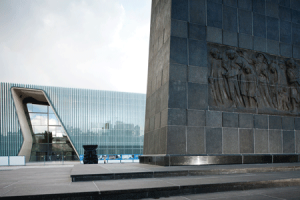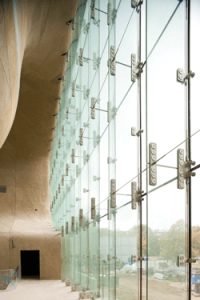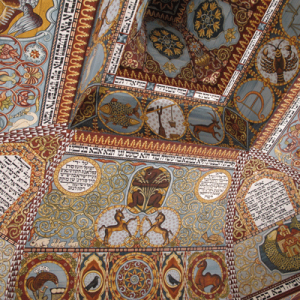Wider World
Life + Style
Arts
Feature
The Arts: A Museum in the Void

Since it opened its doors last April during high-profile ceremonies marking the 70th anniversary of the Warsaw Ghetto Uprising, the Museum of the History of Polish Jews has attracted thousands of visitors—despite the fact that its permanent exhibit will not debut until some time next spring. a “It is a fully functional cultural center,” said Piotr Kossobudzki, spokesman for the $100-million institution. “We are running a complete variety of programs—concerts, performances, cinema, temporary exhibits, classes, school programs. All that is missing is the core exhibit.”
A major draw, in fact, is the striking building itself, a shimmering, flattened cube set in the heart of the city’s prewar Jewish quarter and World War II Nazi ghetto whose every detail is imbued with symbolism.
Its minimalist, copper-and-glass façade is broken by a vast irregular gap that resembles a tav, the last letter of the Hebrew alphabet, and evokes the rupture caused by the Holocaust. Etched over and over on narrow, vertical glass panels is the word Polin in Hebrew and Latin letters.
Polin is Hebrew for Poland. The word has also been interpreted as a welcoming expression, Po-lin—po (here) lin ([you should] dwell)—a definition that underlies the museum’s message that Jewish history here is inextricably entwined with that of Poland.
Designed by Finnish architect Rainer Mahlamäki of Lahdelma & Mahlamäki Architects, the building faces the Monument to the Ghetto Heroes that was erected in 1948 atop the rubble left when the Nazis crushed the uprising. Mahlamäki titled the design “Yam Suf” (Sea of Reeds) and, inside, the walls of the lobby form a curving, canyon-like space designed to evoke the parting of the Red Sea; the soaring glass entryway frames the monument, making a direct connection between past, present and future. Or, as the architect’s Web site puts it, “a rite of passage or transcendence between the long trajectory of Polish Jewish history and a symbolically generous opening to a pacific and fertile culture.” The mezuza affixed to the entrance is made from the brick of a prewar building that once stood nearby.
Nearly two decades in the making, the museum will narrate 1,000 years of Jewish presence in Poland, from early medieval times to today. The aim is to fill a gaping void in collective consciousness about the Jewish experience here and in doing so serve as a counterweight to the heavy, dark reality of Auschwitz.
“I see the museum as a meeting place, a forum and a bridge across the chasm of the Holocaust,” said Barbara Kirshenblatt-Gimblett, the New York University professor who heads the team developing the core exhibit.

Photoby Juha Salminen.
An award-winning author and essayist whose focus is on Yiddish and Polish Jewish history, Kirshenblatt-Gimblett has spent much of the past seven years in Warsaw. “This museum is truly an international museum and site of conscience,” she said. “As such, it has the potential to be transformative not only for its Polish visitors, who will make up more than half of the audience, but also for its international Jewish visitors.”
The concept has not been an easy sell. “There are people who believe that all remaining objects…related to Jewish history should be transferred to Israel as there is no more Jewish life in Poland,” Krzysztof Sliwinski, Poland’s former government liaison to the Jewish world, told The New York Times in 1996, around the time that the idea for the museum first arose.
Some 3.3 million Jews lived in Polish lands before the Holocaust; 3 million were murdered. As much as 80 percent of Jews in North America trace their ancestry to Poland, and many view the country as a vast Jewish graveyard where locals, as the late, Polish-born Israeli Prime Minister Yitzhak Shamir once put it, “imbibe anti-Semitism with their mother’s milk.”
Most jewish survivors fled Poland following postwar pogroms, and a communist anti-Semitic campaign in 1968 forced most remaining Jews to leave. Nonetheless, the decades since the 1989 fall of communism have seen a revival of Jewish communal life and identity as well as widespread interest in Jewish culture among Polish nonJews. Poland and Israel have also developed close ties. Despite this, Jewish-Polish relations remain rocky at times. In July, for example, Poland’s parliament rejected a government-sponsored bill that would allow Jewish and Muslim ritual slaughter. The vote came under pressure from animal rights activists, but many Jewish observers saw it as an anti-Semitic move.
“One of our greatest…challenges has been communicating to American Jews why this museum should matter to them,” Kirshenblatt-Gimblett said. “It is hard for them to understand why we are creating this museum in Poland.”
Funding problems and political and administrative setbacks as well as the ambivalence manifested by many Jewish institutions thwarted development of the museum. A public-private partnership, it has been financed by the Polish state, the city of Warsaw (which donated the land) and numerous institutional and private donors.

Over the past decade, Polish-born Jewish philanthropists such as Tad Taube and Sigmund Rolat have championed the cause. Taube Philanthropies and the Koret Foundation together provided $16 million since 2007, the largest private commitment to the core exhibition. Polish businessman Jan Kulczyk, who is not Jewish, donated more than $6 million.
Taube, who was born in Krakow and immigrated to the United States in the 1930s, sees the museum as a powerful expression of the changes in Poland since the fall of communism.
“To view Poland today solely through the prism of anti-Semitism and the Holocaust is to sadly miss the most remarkable rebirth of democracy and Jewish culture in our lifetime,” he said. “[The museum] realizes the dream of the Warsaw Ghetto fighters: Polish Jewish life has a visible past and a resurgent future. [It will serve] as a singular location where multi-generational, multicultural rethinking and reclaiming of Jewish identity, history and heritage can take place.”
The museum’s core exhibit will be displayed in eight galleries arranged by both chronology and theme: “Forest,” “First Encounters” (the Middle Ages), “Paradisus Iudaeorum” (15th and 16th centuries), “Into the Country” (17th and 18th centuries), “Encounters with Modernity” (19th century), “The Street,” “Holocaust” and “Postwar.”
It will primarily use multimedia installations and interactive technology to tell multiple stories. “We think of our exhibition as a theater of history,” Kirshenblatt-Gimblett said ahead of the opening in April. “Visitors will find themselves immersed in a place, in a time and in the lives of the people whose stories we tell.”
The museum’s first temporary exhibit, “Letters to Afar,” which ran from May to September, illustrated this concept. An audiovisual installation by Hungarian artist Peter Forgacs, with music by the Klezmatics, it created an almost palpable living world through the use of home movies shot by Jewish immigrants to America in visits back to their hometowns in the 1920s and 1930s.
The exhibit was the first collaboration between the museum and YIVO Jewish Research Institute in New York, whose library and archival collections form the world’s single greatest resource for the study of Central and East European Jewish history. The two institutions signed a partnership agreement in 2012.
The museum’s current exhibit, “The Biography of Things: Donations from the Collection of the Museum of the History of Polish Jews” is from the museum’s growing collection. The exhibit, which runs through February 17, 2014, “is devoted to objects donated to the museum,” said Tamara Sztyma-Knasiecka, who curated the show, “and what they mean to the museum and our mission.”
The core exhibit will include nearly 200 original objects as well as facsimiles and reproductions. These, however, will not be displayed simply as artifacts, Kirshenblatt-Gimblett said, but, rather, “will support the historical narrative and add emotional depth to the visitor experience.”
A rare, one-sided coin, or bracteate, minted in the 12th century and bearing a Hebrew inscription, for example, will feature in the museum’s presentation of Jewish economic activity in medieval Poland. It is both an important artifact but also a means of telling the story of Jewish minters and the relationship between Jews and Poland’s rulers. Visitors will be able to learn more about this coin and others like it through an interactive presentation that lets them design their own bracteates.
Other objects in the core exhibit will range from 17th- and 18th-century books and documents and early editions of Abraham Goldfaden’s Yiddish operettas to the “attic diary” kept by a woman in hiding during the Holocaust. There is also a silver cigarette case engraved with an image of the Warsaw Ghetto heroes monument; original paintings; and copper repoussé, a hammered metal technique favored by Jewish artists.
The exhibit’s physical centerpiece is already installed—a spectacular reconstruction of the roof and intricately painted ceiling of a 17th- to 18th-century wooden synagogue from Gwozdziec, now in Ukraine. Over 200 elaborate wooden synagogues once stood in the region; all were destroyed in World War II.
The brilliant tapestry of the ceiling’s decoration combines folk art and Jewish symbolism in a way that is so spiritually dazzling, many have dubbed it a Jewish Sistine Chapel. A mesmerizing array of Hebrew inscriptions, lions, griffins, zodiac signs, birds, flowers, unicorns, plant motifs, geometric forms and more covers the entire inner surface in glowing tones of red, blue, yellow, teal and brown. So compelling are the images that they became signature decorations on a range of souvenirs in the gift shop—magnets, mugs and notepads.
Construction and painting of the ceiling and a replica wooden bima were carried out by students and volunteers in workshops overseen by Handshouse Studio, a Massachusetts-based nonprofit. Major funding came from philanthropist Irene Kronhill Pletka, who was born in Shanghai, in honor of her Polish Jewish parents who had fled there after the Nazis invaded Poland.
The museum is not an isolated institution, nor is its mission totally unique. Though its scope and prominence far surpass other initiatives, it is representative of a new crop of Jewish exhibits and venues that focus not on static displays of Judaica and not on the Shoah but on the living Jewish world that was destroyed.
This trend has been exemplified most recently by the new permanent installation “Shoah,” curated by Yad Vashem in Jerusalem and opened in the Block 27 barracks at the Auschwitz-Birkenau State Museum. This, like “Letters to Afar,” employs a variety of prewar film clips showing Jews carrying out all sorts of activities. Its soundtrack merges spritely music with sounds of celebrations, street life and snippets of conversation.
Nearby, in Oswiecim, the town where the Auschwitz camp was built, a small museum at the Auschwitz Jewish Center, located in the town’s one surviving synagogue, presents prewar Jewish life in a town that before the Holocaust had a predominantly Jewish population. “No one knows that there were Jews here before the war—they only know the death camp,” noted Shlomi Shaked, a volunteer at the center. His mother, born in Oswiecim in 1949 and a resident there until her family immigrated to Israel in 1962, is featured in the exhibit. “I think people who visit Auschwitz should come here first to see the life before they visit the camp,” he said.
A new Jewish museum housed in a restored synagogue in the small town of Chmielnik, north of Krakow, also showcases prewar Jewish life: After all, noted local historian Piotr Krawczyk, before the Holocaust, 80 percent of Chmielnik’s population was Jewish. That means, “local history is Jewish history,” he said.
One of the key roles of the Warsaw museum will be to support local initiatives. “Until our museum was established there were no proper models in Poland for what to do,” Kirshenblatt-Gimblett said. “We can open a new perspective on how Jewish history and heritage can be presented to the public.”
Moreover, she added, “I would like to think that this museum would validate any impulse in these small places to do whatever they can to recover their Jewish past.”
One museum initiative already plays a major role in this regard: The Virtual Shtetl project, a vast Web portal that posts news and information about Jewish heritage and history in more than 2,300 towns, cities and villages all over historical Polish lands, including places now in Belarus, Lithuania and Ukraine.
In operation for more than four years, Virtual Shtetl receives 120,000 hits a month. About half of the visitors find the site because of an interest in local history, said Virtual Shtetl’s founder, Albert Stankowski, who manages the museum’s digital collections.
“You can’t be a local patriot without knowing about Jewish heritage,” he said. “People find our Web site by searching for the name of their towns—and then they find out things that they never knew.”
In fact, enhancing an understanding of identity—Jewish and Polish—places the museum within a broader context. “The museum is the synthesis…the coalescence of getting people to understand the other half of the Polish Jewish experience, the other half of the story,” said Poland’s American-born chief rabbi Michael Schudrich.
Eventually, it is expected to form part of a network of museums offering different perspectives on Polish history. These include the Warsaw Rising Museum, which opened in 2004 on the 60th anniversary of the Warsaw Uprising; a World War II museum; a museum dedicated to Polish-born Pope John Paul II; and one dedicated to Poland’s interwar leader, Marshal Józef Pilsudski.
“There’s a search for a national as well as a more clearly formulated local identity that’s based on history,” said Krzysztof Jaraczewski, grandson of Pilsudski and director of the forthcoming Pilsudski museum. “It’s something that’s got to be part of our daily lives, rubbing shoulders with our heritage.” Jaraczewski, an architect, was an adviser during the competition that selected the design of the Jewish museum.
But heritage and history are different, he noted. “Heritage is a choice we make of those things and values we want to hand down to the next generation,” he said. “It’s a selection, and that selection is a process about creating our own identity. And the history is the background to it.”
The museum is a shared responsibility of both Jewish and non-Jewish Poles, said Katka Reszke, author of Return of the Jew (Academic Studies Press), a book exploring identity issues among young Jews in Poland today.
“In fact, it should probably also be the responsibility of those Jews outside of Poland who are committed to the idea of preserving Polish Jewish heritage,” she added. “The museum represents both Polish history and Jewish history but it also epitomizes Polish-Jewish relations, and with the ambition of presenting an open-ended narrative it is and will continue to be a process.”
Ruth Ellen Gruber’s Web site is www.ruthellengruber.com.










 Facebook
Facebook Instagram
Instagram Twitter
Twitter
Leave a Reply